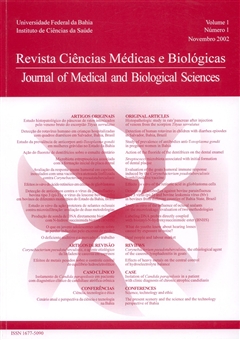Labeling DNA probes directly coupled with biotinyl-N -hydroxysuccinimide ester (BNHS)
DOI:
https://doi.org/10.9771/cmbio.v1i1.4110Keywords:
Biotimilation, DNA Probe, Corynebacterium pseudotuberculosis, Biotinyl-N-hydroxysuccinimide ester, DNA hybridization.Abstract
The use of DNA probes in gene analyses in a solid phase has expanded from research to routine diagnosis in medicine or veterinary plant breeding and forensic science. Those probes have been used since the introduction of the hybridization technique described as southern blotting, which involves the immobilization of electrophorectically separated fragments of DNA onto a filter, followed by hybridization to specific DNA probe sequence. Another technique described as dot hybridization is less complex than the conventional southern blotting; no electrophoretic step is required and it is less demanding on DNA quality because no digestion with restriction enzyme is performed. The most commonly used label in those probes is the radioisotopic 32Phosphorus, which needs authorization for using; it is expensive, hazardous, and has extremely short lifetime besides its high sensitivity. A lot of alternatives to 32P label have been used, with direct or secondary labels. Among them, the biotin-labeled probes have shown great advantages and have successfully been used in specialized and well equipped laboratories. This study reports a modification of the classical method described for DNA probes coupled by hidrazide biotin (REISFELD, 1987). In our work we have used biotinyl-N-hydroxysuccinimide ester (BNHS) in dimtehylformamide to label cytosine residues of available single-strended DNA segments extracted from Corynebacterium pseudotuberculosis. The variation in the rate of biotin and DNA as well as its specificity and sensibility were carefully tested and criteriously analyzed by adsorption genomic DNA of C. pseudotuberculosis and other DNAs in nitrocelullose paper followed by incubation with previously mentioned biotinilated probes, peroxidase avidine and revealed with peroxide hidrogen and 4-cloro alpha naphtol. The results showed that the produced DNA probe have the desired good characteristics. This alternative method, which can be employed with the DNA of other microorganisms, may produce, in an easier way, non- radioactive probes, making that procedure less expensive, more rapid and safer since the nick translation is not necessary, neither the use of radioactive products nor the use of hidrazide. This specific probe can be used on the diagnosis of C. pseudotuberculosis infection in goats and sheep.Downloads
Download data is not yet available.
Downloads
Published
2002-07-13
How to Cite
Freire, S. M., Nascimento, I., Simões, J., Costa, M. de F. D., Schaer, R. E., & Meyer, R. (2002). Labeling DNA probes directly coupled with biotinyl-N -hydroxysuccinimide ester (BNHS). Journal of Medical and Biological Sciences, 1(1), 80–85. https://doi.org/10.9771/cmbio.v1i1.4110
Issue
Section
ORIGINAL ARTICLES
License
The Journal of Medical and Biological Sciences reserves all copyrights of published works, including translations, allowing, however, their subsequent reproduction as transcription, with proper citation of source, through the Creative Commons license. The periodical has free and free access.


